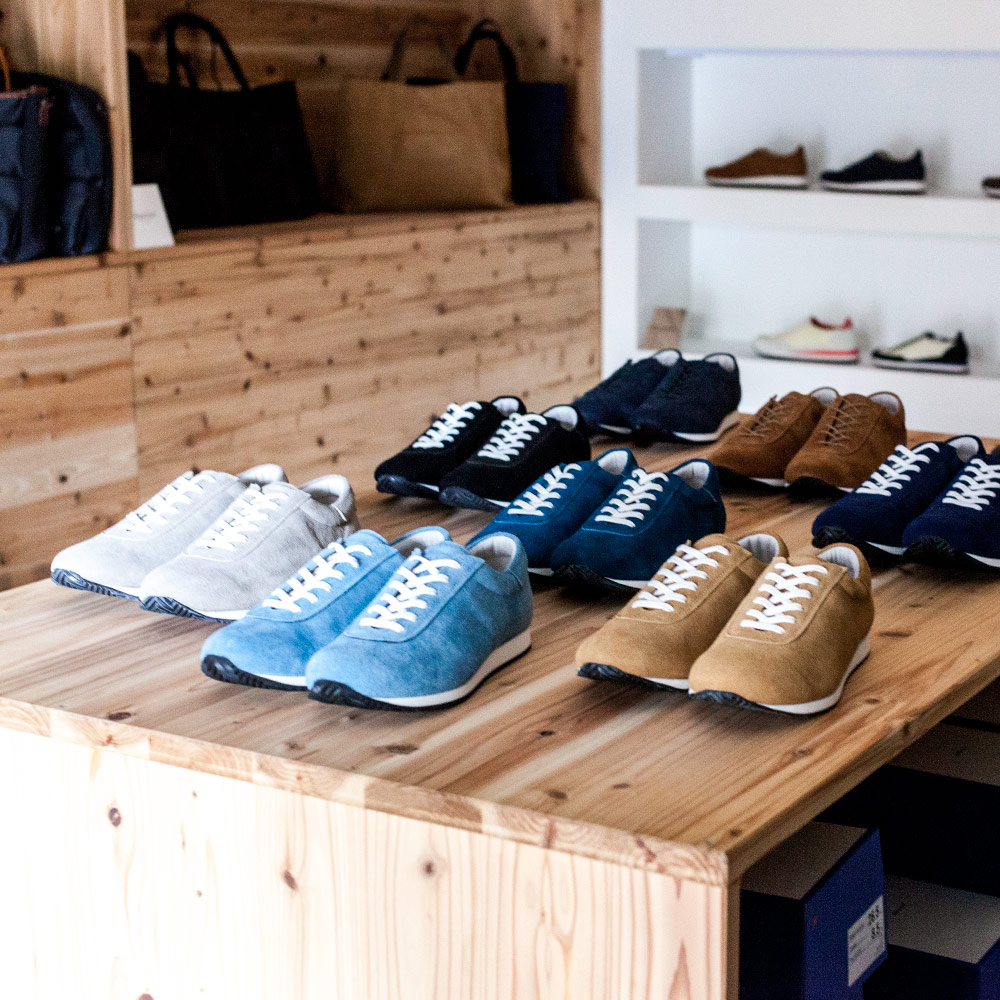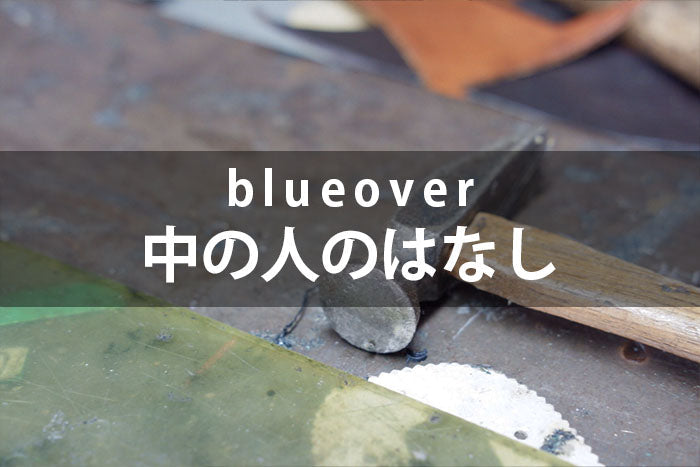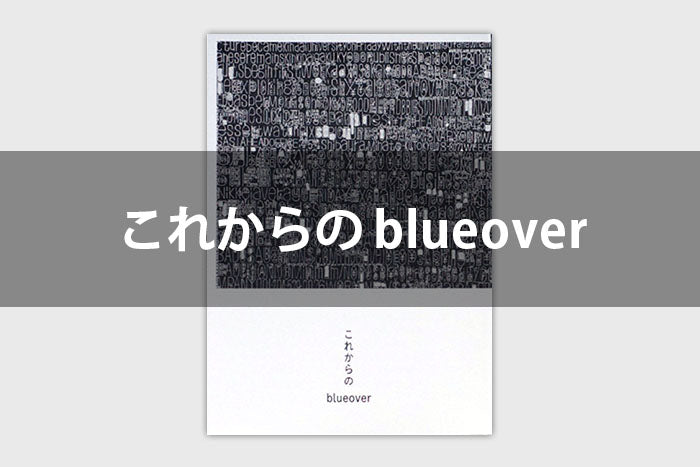Concept in-depth interview
Blueover has revamped its concept. We explore the reasons and meaning behind it...
We buy things because we like the design and functionality. That used to be our norm. But that norm is now changing. For example, no matter how convenient or stylish a product is, what if we mass-produce more than we need and then mindlessly throw away the excess? Even if we like the design and functionality of the product itself, if the brand's backbone and vision don't suit us, we won't buy it. That's what's likely to become our next norm. I have a feeling that's happening.
Not only because of this, but to mark its 10th anniversary, Blueover has updated its concept statement. The new concept statement is perhaps best described as a more detailed explanation of the brand's philosophy, while retaining the same principles. It contains the brand's background, its approach to craftsmanship, and the thoughts it wants to share with those who wear its shoes.
[Full concept]
This concept statement is over 2,500 characters long. As the title suggests, it's too long for a concept! However, I've tried to keep it as concise as possible and summarised it to this length. I think you can already see the depth of my thoughts that went into this statement. However, there are many parts that I didn't touch on in order to keep it simple.
So in this content, staff member Egawa will be digging deeper into the content by asking questions to designer Watari, who wrote the brand concept statement, while also referencing the concept statement little by little.
Profile
Watari
He is the founder and designer of Blueover. His hobby is wood carving. His favorite car is the first generation Honda City E-AA.
Egawa
A staff member at Blue Over/Struct. She enjoys crafting on her days off. She's happy when she can use the things she makes right away.
Egawa
I've finally completed the concept for Blue Over after writing and editing it over and over again, but I've cut out a lot of parts in order to make it a readable length. I'd like to ask Watari, the author, some questions about the key points of the text so that I can fully understand those parts.
Watari: Yes! Thank you very much.
Egawa
Now, let's take a look at the original concept statement.
The Beginning
Blueover is a sneaker brand born in Osaka. While working as a freelancer in product design, I (Hitoshi Watari) began to question the cycle of product development and consumption.
Egawa
I have a question for you. The literal translation of the term "product design" is "design of products." Specifically, what kind of things were you designing?
Watari
I often worked on sports equipment and home appliances. At the time, terms like UIUX were rare, and I mainly designed the exteriors of so-called hardware products.
Egawa
In fact, both sporting goods and home appliances fall within the broad field of product design. At first glance, it may seem surprising that they are from different fields, even though they are both created by the same designer. ...If I expand on this topic, I'll get sidetracked, so let's get back to the main topic.
While working on these products, he began to question the cycle of consumption.
Watari
After all, to get people to buy their products, companies have to produce exciting things every year. I fully understand the logic behind this, and in some ways I think that's how it should be, but in this cycle, the act of producing things encourages instant consumption. When this happens, it's easy to end up with designs that are merely cosmetic, and I think it creates an environment where things with real value are hard to create and understand.
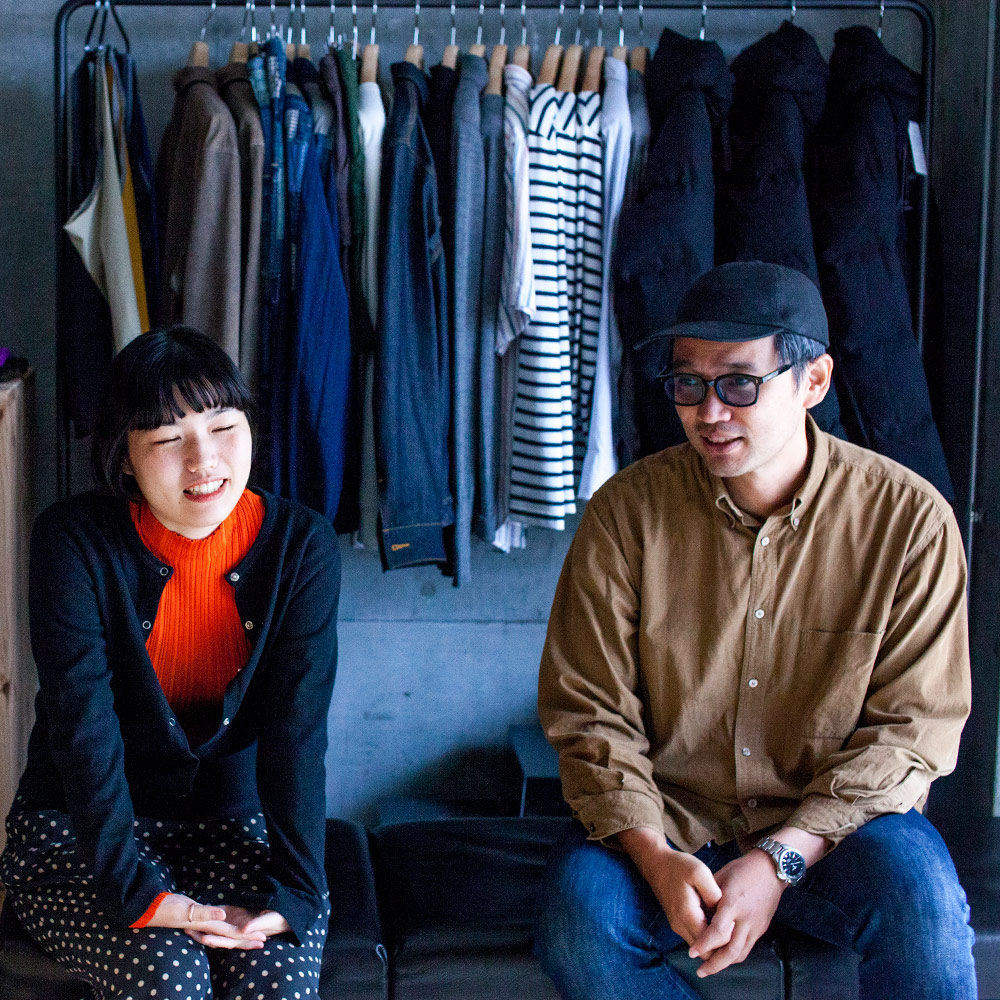
Egawa
I see. It's true that even though the "things" themselves aren't old, new things keep coming out that aren't that different in content, and the things made a long time ago seem old in comparison. I find it strange that this cycle has become so normal...
...Furthermore, after witnessing the decline of domestic manufacturing plants, he launched Blue Over in 2011, hoping to bring about change by throwing himself into that cycle.
Egawa
Was there any particular event that led you to launch Blue Over in 2011?
Watari
In the 2000s, the recession hit, and as cost competition in the market intensified, many shoe manufacturers shifted to Asia. This led to further cost competition, accelerating the consumption cycle, and the small factories that remained in Japan were forced into an increasingly difficult situation. Ultimately, more and more small factories that had continued to produce domestically withdrew or went out of business. Witnessing this was one of the triggers.
Egawa
So you had connections with small shoe factories like this even before you started Blueover. Are those the sporting goods factories you mentioned earlier?
Watari
That's right. I went in and out of various factories, both large and small. There I spoke directly with the craftsmen and also with the factory presidents. I also got a sense of the situation I mentioned earlier from the atmosphere on-site. Seeing the background of production like that, and thinking about what I could do as a freelancer, I got the idea that I could take action for local production areas. And that's how Blue Over came about.
Egawa
That's how Blue Over was born, and that's why we've been committed to being made in Japan for the past 10 years.
Now, let's move on to the next chapter and read about the background of Blueover's shoemaking.
Shoemaking background
Shoes are made up of many materials, such as the upper, sole, laces, and insole, and each of these goes through a manufacturing process in small-scale manufacturers with a division of labor.
Egawa
This means, to put it simply...
Watari
So the upper, sole, laces, and insole are all made in different places.
Egawa
Of course, the "places" where they are made are different, but it's not like one big company has factories in various places, but rather the people and companies that run each one are different, right?
Watari
That's right. Furthermore, when it comes to the upper, the company that sells the leather material and the company that processes that material into the shape of the upper are also different.
Egawa
This then leads to the division of labor into companies that sell sole materials, companies that process soles, etc. Shoemaking is actually a lot more divided than is written in the concept document.
Shoes really take a lot of time and effort...
Due to various reasons, including issues of succession, an aging population, and cost competition overseas, it is becoming increasingly difficult to produce sneakers entirely within Japan. However, Blueover procures as many materials as possible domestically and continues to manufacture its products. While we are not a large-scale operation, we hope to maintain our domestic manufacturing base by leveraging connections between factories and the local community.
Egawa
I think it was difficult to touch on this point in the concept statement, but what is the reason behind the fact that it is becoming difficult to produce sneakers entirely within Japan?
Watari
The reason for the difficulties is that, simply put, "making and selling shoes domestically doesn't make money. So the number of manufacturers is not increasing and many are disappearing."
Egawa
Going further, why doesn't it make money?
Watari
As I mentioned earlier, shoes are made by the hands of many more people than you might think. This means that to complete a component, labor costs (labor costs) are also incurred in addition to the time and skill required to process it. Labor costs vary by country and region, so if you compare Japan with Asia, Asia is naturally cheaper. As a result, shoes made domestically end up being significantly more expensive than shoes made overseas.
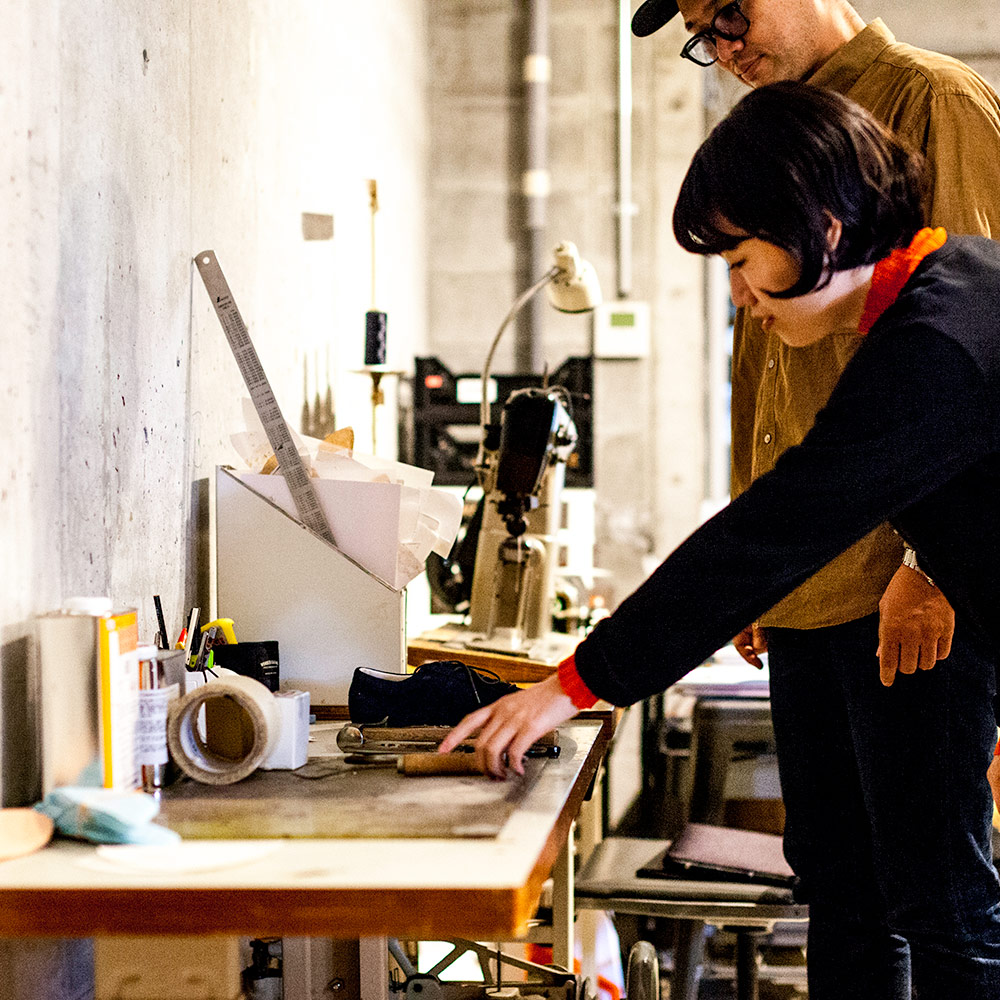
Egawa
I see, so roughly speaking, labor costs are the reason you can't win the price war...
Watari
This means that fewer brands will outsource their production to domestic factories, and as there will be no sales, the number of places to make shoes in Japan will decrease rather than increase.
Egawa
I understand that, but even if you exclude manufacturers that have had large shoe factories in Japan for a long time, you can often see Japanese-made shoes other than Blue Over. What's more, they are usually cheaper than Blue Over.
Watari
That's right. There is a method called knockdown, where the upper and sole are imported as semi-finished products and then assembled domestically to make shoes. Shoe factories that do this (the final step in making shoes) are relatively large, so they still exist in Japan.
Egawa
Even with that manufacturing method, Made in Japan is still Made in Japan.
Watari
That's right. What this means is that the quality of the shoes is guaranteed in the final process, "shoemaking," and the fact that Japanese manufacturers (factories) are responsible for the final process is proof that this quality is guaranteed. Both the uppers and soles of our products are made domestically, but from the customer's perspective, they are all "Made in Japan."
Egawa
I see. Blueover is committed to producing all of its products in Japan as much as possible.
Watari
Honestly, I think we need to think about what the point is of making everything domestically. Looking at apparel, which is 98% imported, it seems we can't change the flow of the times. It's important to think about what actions we should take based on that.
Egawa
When you think about your next steps, do you think the feelings you had about local industries when you first started the brand play a big role?
Watari
I think knockdown is also a viable option. However, even though it is becoming less common, as long as there are craftsmen in Japan who are involved in the detailed work of cutting, sewing, skiving leather, insoles, and auxiliary material wholesale, I would like to stick to domestic manufacturing as much as possible. If possible, I would like to preserve the cultural assets that our predecessors have passed down from the past. I think that this activity is the very meaning of the brand.
Egawa
When I see Watari and shoemaker Azuma taking the time and effort to source materials and coordinate with the factory, I think, "It's impossible for someone to imitate Blueover, which carries out almost the entire shoemaking process domestically. That's why Blueover is a one-of-a-kind brand." But at the same time, I'm worried that if they don't do more to promote the brand, they won't be able to stop the factory from gradually declining...
Let's go back a bit and look at the rest of the original text.
...Why is that?
I was born and raised in the late 1980s to 2000, a time when Japan was known as a manufacturing powerhouse, and I was involved in product design and visited many different factories. I wanted to give back to the manufacturing industry that has supported Japan up until now.
Egawa
This is a bit of a repetition of what I said earlier, but it explains why Blueover does as much of the manufacturing process as possible in Japan. When I read this, I feel that Blueover doesn't just make shoes, but that words like "efforts" and "challenges" really suit them.
Watari
I think that the formative experiences of childhood are what form our identity. In that sense, the 1980s to 2000s was the era of things. I grew up surrounded by things, excited and stimulated by them. I think the reason I decided to pursue product design as my previous job was because of the influence of that era.
Egawa
I was born in the 90s, so I remember feeling a faint scent of that era.
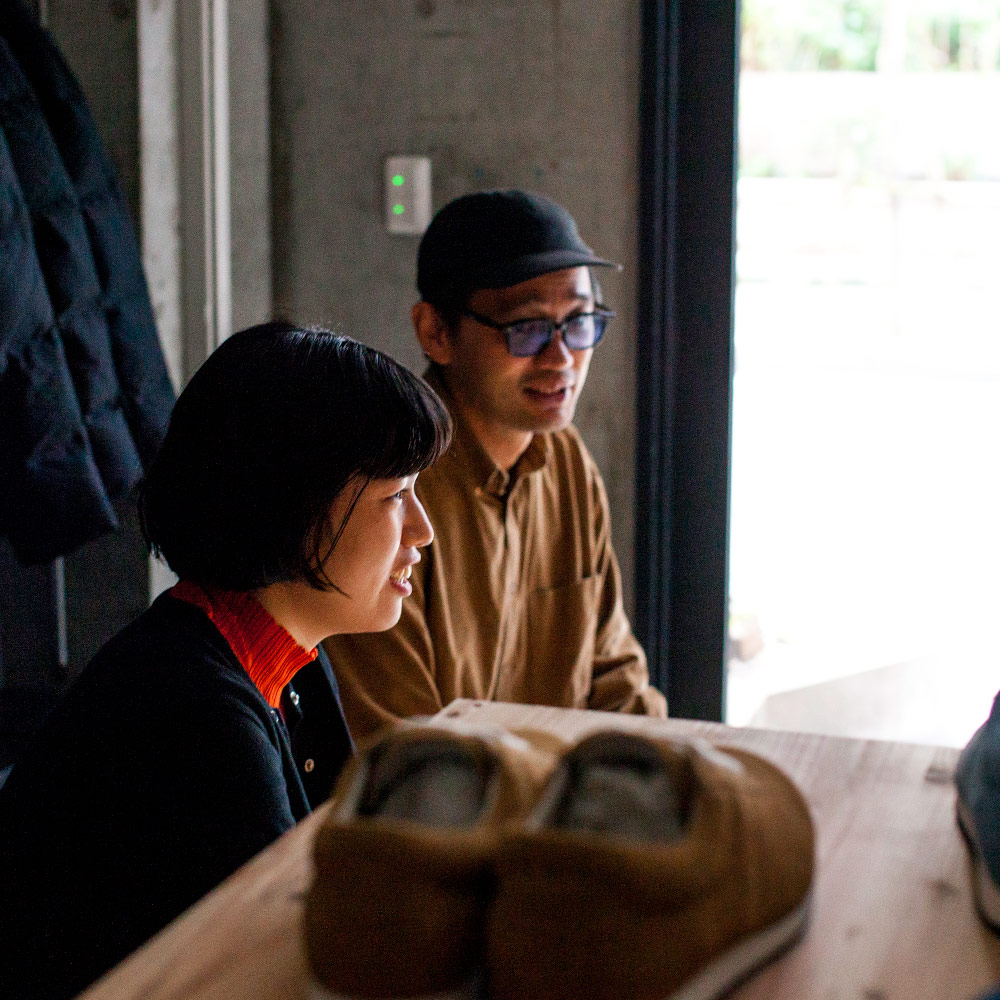
Watari
I really love the smell of the machines and the scenery when I enter a manufacturing site (factory), and it inspires me. Writing about giving back sounds grand, but I simply don't want to lose the place where we make things so close to us. That's all I think. What can we do to prevent it from being lost? In that sense, I think Blue Over is not just about shoes, but also about words like "effort" and "challenge."
Egawa: That's true. As a member of the brand, I want to continue to take on bold challenges.
Influence of the Mingei Movement
In my work (product design), I am influenced by one movement: the Mingei movement advocated by Muneyoshi Yanagi.
Egawa
Speaking of Soetsu Yanagi, he is the father of Sori Yanagi, a master of product design. Sori Yanagi is a famous designer who is a must-know for people who study or have studied design, such as Watari and me. Even if you have not heard the name, I think many of you have seen his cutlery and kitchen tools.
Watari
That's right. In fact, it was the products that Munemichi created that first introduced me to Mingei.
Egawa
I see. How did you then become interested in Muneyoshi's folk art?
Watari
When I first became interested in design, among the various industrial products, Munemichi's product designs were particularly appealing. The designs were streamlined and rational, yet still had a warmth to them. I was simply drawn to the form at the time. Unlike other uniform industrial products, I remember feeling like I could see a person in them.
Egawa
What do you mean, you can see people?
Watari
Perhaps I felt something like the intimacy that philosopher Takashi Kurata talks about. From there, I wondered why the shapes and atmosphere created such an intimacy. By digging deeper to find out, I ended up finding the folk art of my father, Muneyoshi.
Egawa
Watari-san became interested in fellow product designer Munemichi, which led him to learn about his father, philosopher Muneyoshi, and to be influenced by him. When I was a student, I only learned about Mingei in outline, so after joining Blue Over, I looked at Muneyoshi's books and learned more about it. If you look at the website of the Japan Folk Crafts Association, you'll find the following written about the characteristics of Mingei:
Practicality. It is not made to be admired, but to serve some practical purpose.
Anonymous. It was made by an unknown craftsman, not by a particular artist.
Plurality. They were created in large numbers to meet the demands of the people.
Affordability. It is cheap enough that anyone can afford it.
Labor-based, involving skilled techniques acquired through repetitive, hard work.
Regional characteristics. Each region is rich in local color, with unique colors and shapes rooted in the lifestyles of each region.
Division of labor. To produce a large number of items, collaboration among multiple people is required.
Tradition. Tradition is preserved through the accumulated skills and knowledge of our predecessors.
Other-power. Rather than relying on the power of an individual, it is supported by greater, invisible forces such as the climate, the blessings of nature, and the power of tradition.
Excerpt from the Japan Folk Crafts Association website
Egawa
There seem to be some commonalities with the way Blue Over makes things...
Watari
When I started Blue Over, I wasn't thinking about folk art, but when I looked at its characteristics again, I realized there were some similarities.

The early 1900s was a time when industrialization ushered in mass production. At the same time, crafts became ornate and decorative. Yanagi Muneyoshi, citing this background, argued that true beauty lies in the local climate and environment, in the lifestyles that are rooted in those places, and that the things born from the handiwork of the nameless artisans who work there are a form of "wholesome beauty" that is unpretentious and practical.
Egawa
Here, we are talking about the "beauty" that Muneyoshi discovered in folk art.
Watari
Generally speaking, the standard of beauty in tools up until now has been that they are made from expensive materials or made by famous craftsmen. However, Muneyoshi realized that beauty resides in more than just material things.
Egawa
"Beauty" generally refers to something visually beautiful, but in the definition of Mingei, it doesn't say, "It's beautiful because this is how it is." In other words, it's not about the beauty of the "figure, shape," but honestly, it's hard to tell just by reading it quickly.
Watari
It's certainly difficult to understand. As you say, I don't think the "beauty" shown here refers only to appearance or shape. Mr. Muneyoshi, who was also a religious philosopher, interprets this as showing how to understand beauty from a religious perspective.
Egawa
I have always interpreted Mingei as the "beauty of use" that Muneyoshi spoke of, meaning that use and function lead to beauty.
Watari
Certainly, that's a common way of looking at things. I also had a tendency to see it that way at first, but I think that design has a tendency to try to logically unravel the origins of a tool and connect it to its form. But when I looked at Mingei, I realized that it's not just about functional beauty.
Egawa
Hmm.
Watari
In the first place, the selection of the beauty of original folk crafts is based on his exceptional aesthetic sense, and I personally believe that it is something different from what the world calls folk crafts. There was a folk craft boom a long time ago (around 1960), and the definition was broadly interpreted, and now I think the situation is somewhat chaotic. The folk crafts selected by Muneyoshi at the Folk Crafts Museum are very modern and intuitively beautiful, but there are also some items sold in local shops that I find a little strange that are advertised as folk crafts.
Egawa
It certainly seems like the term "Mingei" has become quite broad in its meaning. ...To put it bluntly, is Blue Over Mingei folk art?
Watari
Having said all this, I have actually never thought of Blue Over as folk art (laughs). It would be strange for me to call this brand folk art in the first place. However, it is true that I was influenced by Mr. Muneyoshi's ideas, and I think the definition he wrote there is wonderful. If someone somewhere said that Blue Over was folk art, I would be very happy.
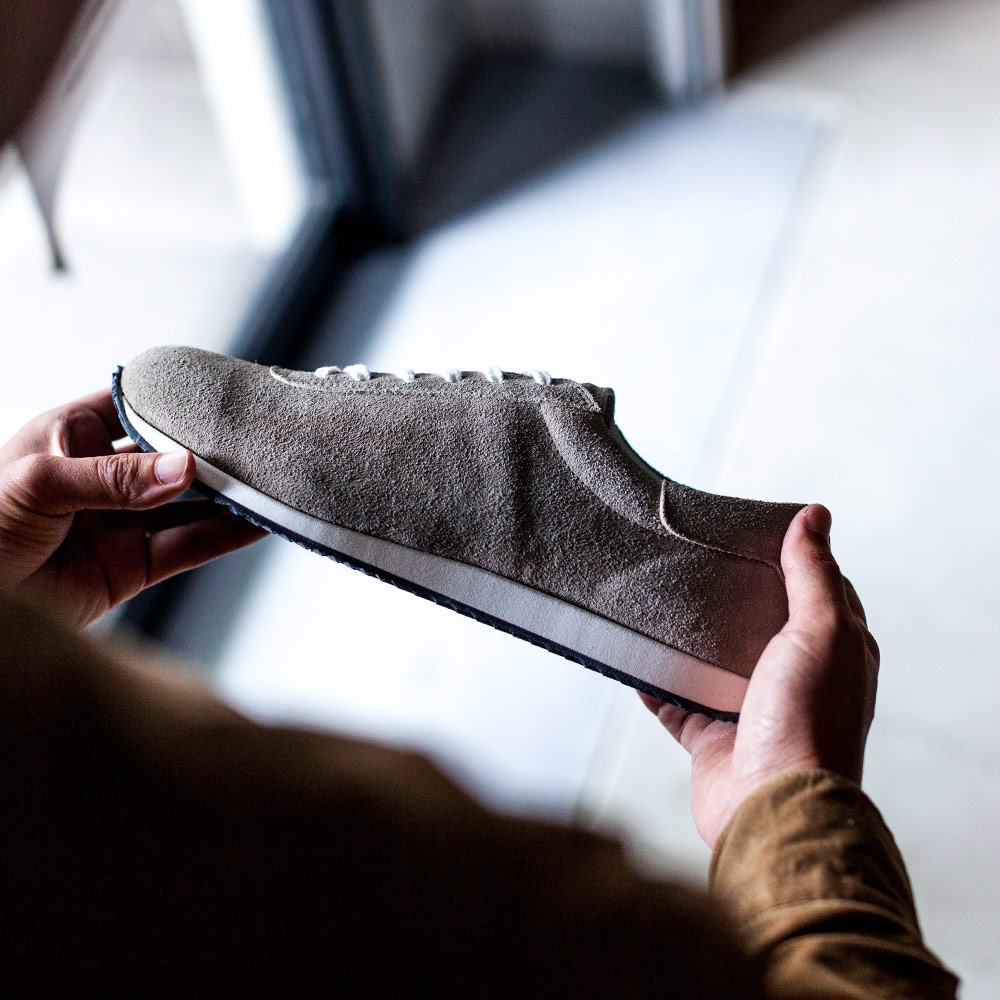
Egawa
I see! That's certainly true, it's not for us to judge whether something is folk art or not... In other words, I agree with Muneyoshi's definition of folk art, but Blue Over is not trying to be folk art.
Returning to the topic of "beauty" for a moment, how do you interpret Muneyoshi's philosophy?
Watari
"Tools are created out of necessity by the people living in the local community. These tools make use of the local climate, and for the local people who live there, making them is also a 'job'. There is no fame or obscurity in them, they simply exist as a natural part of human activities. This cycle of relationships between people and things is very natural, healthy and beautiful!" That's how I interpret it, and I think that's really great. I like the "healthy" part of "healthy beauty." I think it's wonderful to be healthy and beautiful at the same time.
Egawa
The "wholesome beauty" that resides in folk art refers not only to the appearance, but also to the beauty that encompasses the background surrounding it. That's the interpretation. I feel like my own perspective on folk art has changed a little.
Blue Over's simple, rounded appearance and the fact that it's made in Japan. And the word "Mingei." If you just look at those two things, it seems as though they're promoting Mingei (laughs), but in fact, it's not just that. While sympathy with Muneyoshi's idea of healthy beauty is a big factor, there are also many other things that I touched on in the previous article, such as questions about the consumption cycle... Including the points I'll explain and touch on later, the Blue Over brand encompasses many other outputs.
Beauty exists in everyday life. I am strongly influenced by this idea, and I believe that even in modern society, it is important to create designs based on the local culture and cultivated techniques, and I try to avoid unnecessary designs as much as possible. One of Blue Over's activities is to ensure that the artisans (production areas) who can create this healthy beauty do not disappear.
Egawa
They try to avoid unnecessary designs as much as possible... so perhaps that's why Blue Over doesn't have a mark, unlike other brands that are based on mass production.
Watari
No marking doesn't mean anti-mass production, and I don't think it's unnecessary. Recently, there are many brands that have small marks.
Egawa
It's also increasing significantly among clothing brands.
Watari
I think that was the era when there were many designs with large marks on the side.
Egawa
What was once a trend has become established.
Watari
However, the reason why our shoes don't have a big mark on the side is because we thought that the brand name should not come first, but should remain anonymous. It might be a way of expressing our intention that it is the nameless craftsmen who create our brand.

Egawa
Also, because it is relatively unknown, the materials and form are highlighted, making it a truly impressive piece.
Watari
That may be true. When I design, I start by thinking about the strengths of the factory I'm asking them to do the work. If I ask the factory to do something they're not used to with my design, it often ends up with an accumulation of unnecessary elements.
Egawa
When you say unnecessary elements... well, does that include the work processes of craftsmen, for example?
Watari:That's true. On the other hand, if you incorporate the techniques that factories are good at into your design, you can create something very beautiful. The same can be said about materials.
Egawa
In other words, if you try to do something that is too difficult, it will end up being inefficient and unattractive. Blue Over tries to avoid doing anything too difficult, making the most of the strengths of the factory, and seeing the shape that comes out naturally and honestly. I think that this is certainly reflected in the final product.
design
Next, what is the design that Blueover does? It is to design what is commonplace. In other words, the shoes should be "comfortable to wear."
For example, we carve wooden shoes to fit the shape of Japanese feet. We select materials that become more comfortable the more you wear them. We design patterns so that there is no stress when bending the foot. We set the sole hardness to be optimal for walking, not running. We create a timeless look that can be worn continuously regardless of trends.
Egawa
In this section, we talk about what Blueover thinks about when making shoes.
Watari
It's not about special functionality, it's about basic functionality. I think it's important to fulfill that. Our shoes are designed for the most basic action of "walking." So we're conscious of providing basic functionality, not special features.
Egawa
It's not about running fast or jumping, it's about walking naturally.
Watari
Yes, obviously. But I also think that it's very difficult. For example, when you wear a pair of shoes that are very "fluffy" and comfortable, you might think "Wow!" at first, but if you wear those shoes for a long time, they'll end up being tiring.
Egawa
That's right. When I explain this to customers in stores, they are often surprised. It was an eye-opener for me when I first heard it, but when I looked back at the "fluffy" shoes I'd worn up until then, I realized that they were probably making me tired, and it somehow made sense.
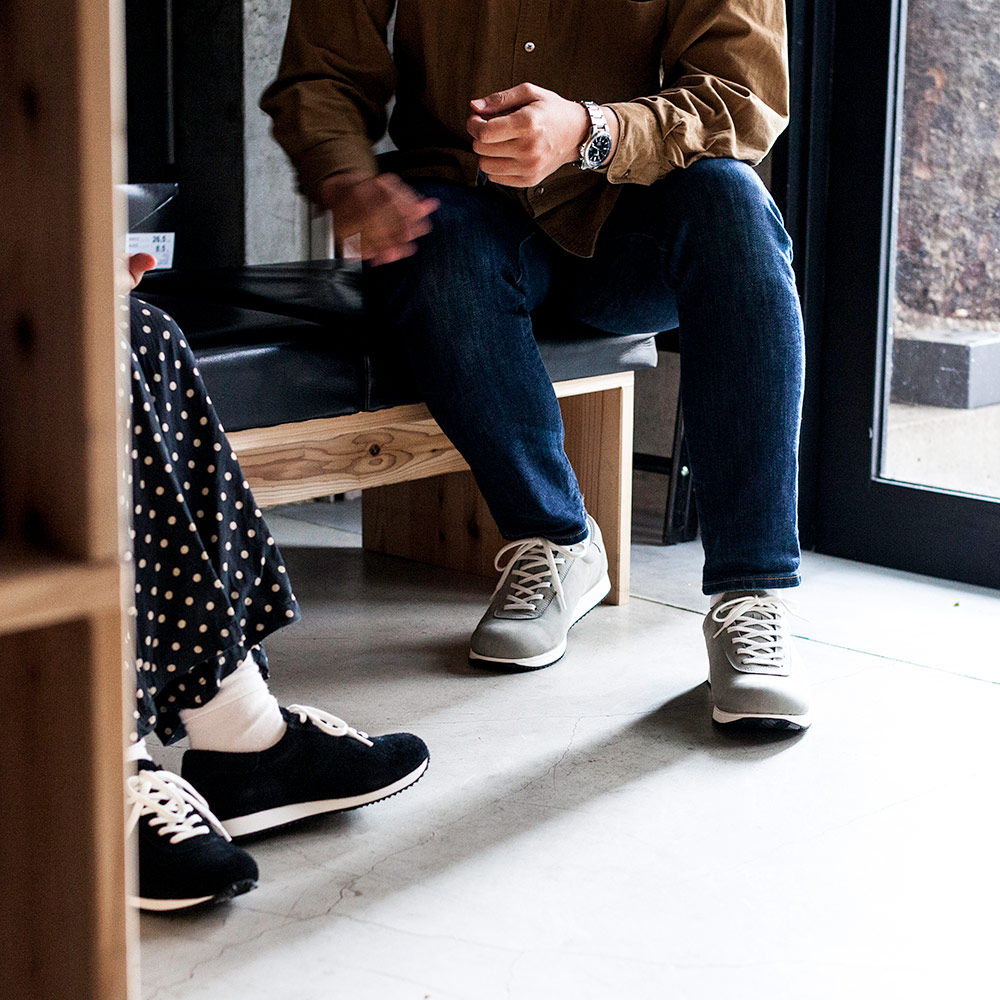
Watari
"Fluffy" means that the sole that supports your feet is not stable, and in that case, your feet are constantly trying to balance themselves to compensate for that instability, which can make your feet tired. But when you first start wearing them, the special "fluffy" feature makes a big impact, and you'll think it's great.
Egawa: To put it in extreme terms, it's the same as walking on a bed and feeling tired. When you run, you need something soft to absorb the shock.
Watari
On the other hand, when you try on the Blue Over, you think, "Hmm, it's just average." Then you don't realize how good it is.
Egawa
In fact, when compared to running shoes, many people might initially think, "What's this? It's hard!" (laughs)
Watari
But this "hardness" is designed to have just the right balance for the movements of "walking" and "standing." And it's only after wearing them for a long time that you realize, "Hey, this is good." It takes quite a long time for people to understand how good they are.
Egawa
That's really so...
Watari
Taking all of this into consideration, I think there's something indescribably difficult about shoes; you try them on and then, over time, you realize how good they are.
So, what I think is best is when the shoes become something that people suddenly find themselves wearing often. I'm happiest when people suddenly realize that they're a regular.
Egawa
I have several pairs! It really gives me strength to hear people say, "I know how good they are!"
The next most important element is "long-lasting use." To ensure that shoes can be used for a long time, durable materials are selected, and the core materials for the toe and heel are also made sturdy. Depending on the model, outsole materials that are resistant to wear and out are used, and manufacturing methods that allow for replacement are used. These may seem like common sense, but they are not easy to achieve. Blueover's designs are about making shoes that can be worn comfortably for a long time.
Egawa
Blueover shoes have a consistent philosophy even when it comes to choosing the materials. That sounds great, but isn't it difficult to balance that with the price?
Watari
I'm thinking about the future of wearing them, but while I'm thinking about the price, I also want them to be shoes that I can wear for a long time because they are shoes that I wear often.
Egawa
...From the way you talk, it seems like it's more difficult to balance "comfort" and "longevity" than to balance price.
Watari
That's right (laughs). We're carefully considering the specifications of the invisible parts to achieve this, but it's not easy to strike a balance.
For example, to wear shoes for a long time, the outsole must be highly durable. However, that means the weight of the item increases. This leads to a loss of comfort. On the other hand, if a lightweight outsole is used, durability is sacrificed, and the disadvantage is that it wears out quickly. That's why I feel that the way Blue Over finds the answer to the question of "the balance between comfort and long-lasting wear" is a distinctive feature. Well, it's hard to tell because you can't see it (laughs).
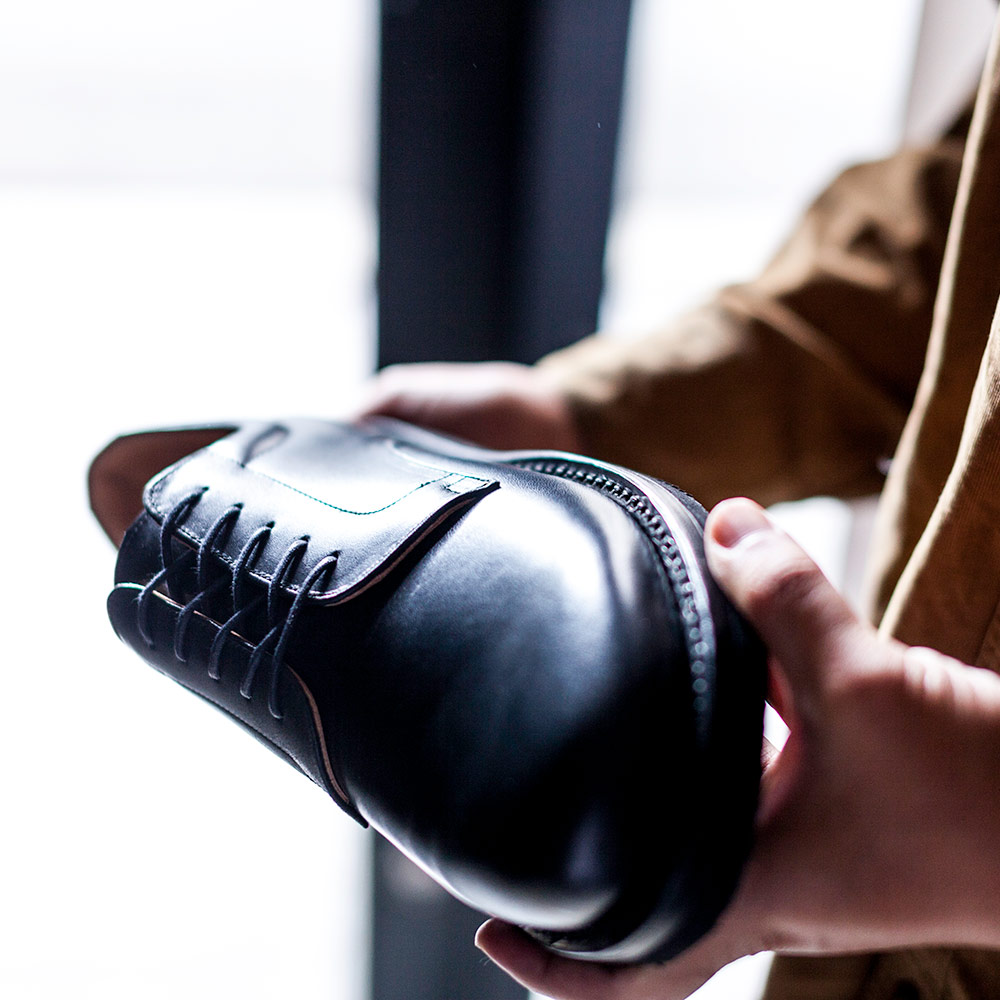
Egawa
Such elements tend to be trade-offs. Especially with shoes, when you consider hard use, it's easy to end up with a trade-off between one thing and the other. If you prioritize both ease of walking and long-lasting wear, you end up packing in contradictory elements.
But rather than choosing one and discarding the other, Blueover is always searching for the right balance, making shoes that can be worn for a long time, while also pursuing comfort. Is that the correct understanding?
Watari
(laughs) Yes. That's the only thing I can say...
Comfort <br>I sometimes think that shoes are very mysterious products. Shoes are tools that connect the wearer's body with the outside world and carry them around. They can be said to be unique beings that straddle the boundary between the body and the ground. They always share time with people, whether they are happy or sad, and accept them as they are. I have always been particularly drawn to shoes.
I sometimes look at the shoes I cherished in high school and recall memories from those days. The emotions that come back to me with these memories are not just nostalgia, but also something akin to affection. Perhaps it's because well-worn shoes literally feel like friends who have shared good times and bad. Blue Over is designed to be comfortable and something that the wearer will want to wear all the time, so that they can build up memories.
Egawa
After reading this, shoes certainly seem mysterious to me. They're like a form of transportation. Are they similar to cars?
How should I put it... Some people think that it's fine if the shoes can be worn, and that the car can move, but there are also people who are particular about whether the shoes are good or the car is comfortable. Moreover, since they travel together, they can make memories. In that sense, they seem similar.
Watari
Hmm. That's true. Now that you mention it, they do seem similar.
Egawa
Watari-san also drives a car that you don't see very often.
Watari
Yes, my beloved City is a bit inconvenient, but I still feel good when I drive it. I chose it based on its features and not its inconveniences.
Once you go out and get in your shoes or car, you have to keep them with you until you get back. There's also a sense of tiredness after you've put them on. I think you definitely feel attached to both of them in that way.
Egawa
…….
I used the car analogy thinking that Watari-san might find it funny, but the truth is, I can't drive a car.
Watari
Are you running?
Egawa
Hahaha. But I also feel that "tiredness" that you mentioned. Of all my belongings, I've grown attached to my shoes, so it's hard to let them go. I wonder if I can still wear them if I take care of them?
Watari
I still have a pair of worn-out Stan Smiths (I think they're real) that I wore in high school, with tiny holes on the sides for some reason, quietly displayed in my house. They're not vintage or anything, so to people who see them they're just worn-out sneakers. They're a memory that's entirely mine alone.
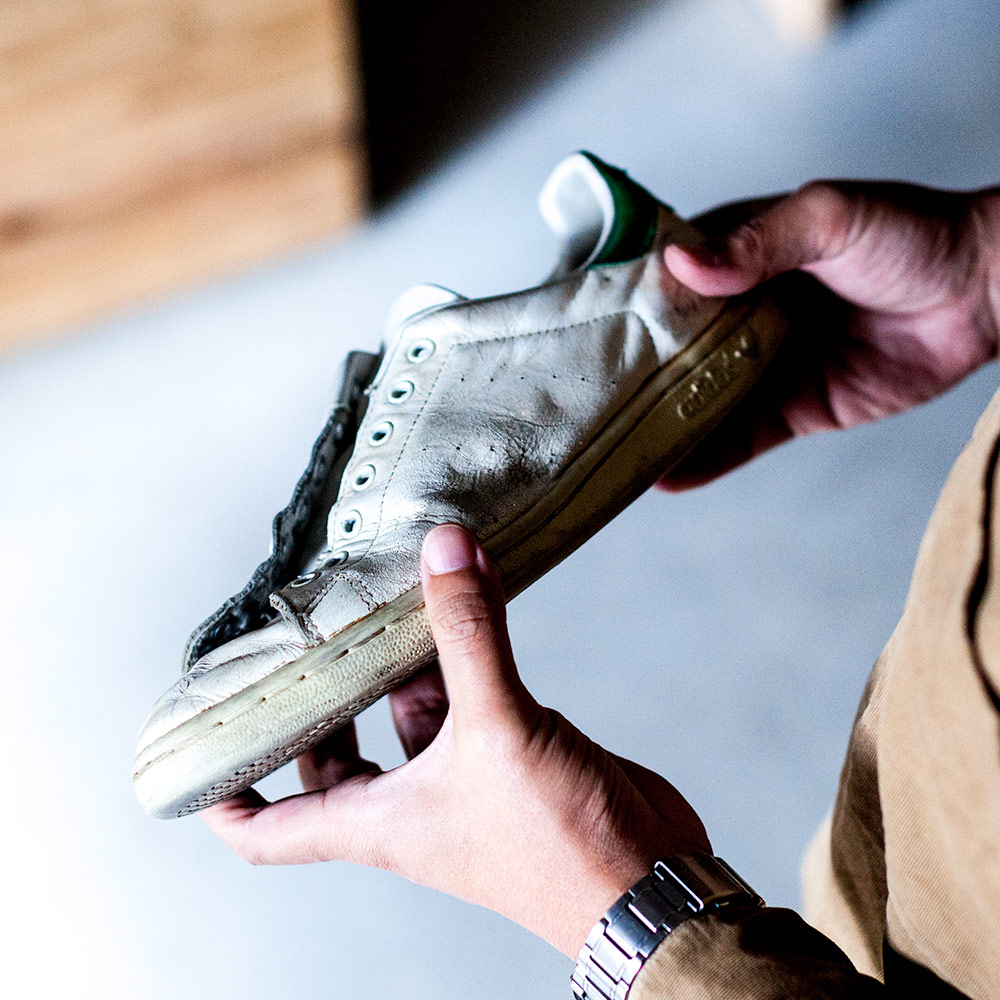
Long-lasting wear <br>Worn-in shoes will develop a unique character from the oils left by the wearer and the wear and tear that comes from being exposed to nature. Shoes that are made to be worn for a long time will be cared for over that time, and will develop even more character. When I see well-cared-for shoes, I sense a sense of richness in them.
Egawa
When I read this part, I nodded vigorously. Of course brand new shoes are cool, but shoes that are well-worn have a special atmosphere.
It's like when you're looking at a magazine and you think, "These shoes are great," and then you look at the credits and you see that they're not a part of a new outfit, but rather the model's or stylist's personal shoes.
Watari
I also think that well-cared-for shoes look really cool. Boots and leather shoes especially. I think, "Wow, they look so cool." People say they want to age gracefully, but I want their shoes to age gracefully, too. That's why I want to make sneakers that grow in the same way.
Egawa
Since they are made to be used for a long time, it would be great if you could have children and pass the Blue Over onto them.
Watari
That's the best!
It may be a matter of feeling, but taking care of things brings comfort, peace and warmth not only to the things themselves but also to ourselves. The fact that Blue Over is a shoe that can be worn for a long time means that the more you wear it, the more expressive it becomes, and I think that it will bring spiritual richness to those who continue to wear it.
Egawa
It's not that we can take good care of our belongings because we have peace of mind, but rather that taking good care of the things around us leads to peace of mind and comfort.
Watari
That's what I want it to be like. Not just shoes, but all things are like crystals created by the hands of many people, and I think of things as a medium for communication between the maker and the user. Rather than seeing things as things, we should see people through things. I hope that by embracing this mindset, people can find the seeds of abundance.

Egawa
Blueover aims to make shoes that the wearer will feel are worth treasuring.
Ordinary yet special shoes
Blueover aims to create shoes with healthy beauty. By wearing them, the relationship between the person and the shoes can become something ordinary yet a little special. Blueover plays a part in protecting and nurturing the shoemaking industry and culture that have been passed down in the local community, as well as the people who work there, and shows that they too can be part of a healthy cycle.
Egawa
We've spent a fair amount of time talking about the concept behind Blue Over, but if I had to pick one highlight, it would be the line we talked about in the second episode: "Blue Over is not folk art."
Watari: That's true. For the past 10 years since the brand was launched, you've been using the word "Mingei" at every opportunity.
Egawa
However, I was strongly influenced by it. Not just the appearance, but the origins and background of "Mingei."
Watari
oh yeah
Egawa
So, the value that Blue Over embodies isn't just what appears on the outside, but also the background behind it... how should I put it, rather than simply wearing shoes, I want people to embrace the history behind the shoes.
Watari
That's right. I hope that through the Blue Over shoes and brand, people will learn about and support the connections between the people who make them, as well as the industry and culture that are rooted in the local area. The craftsmanship and its history that has continued since ancient times has been influenced by and coexisted with the nature of the place of origin, and is itself a "human activity." In that sense, I think that the beauty that we feel in the concept of folk art is beautiful precisely because it is something that we find sensibly comfortable as humans.
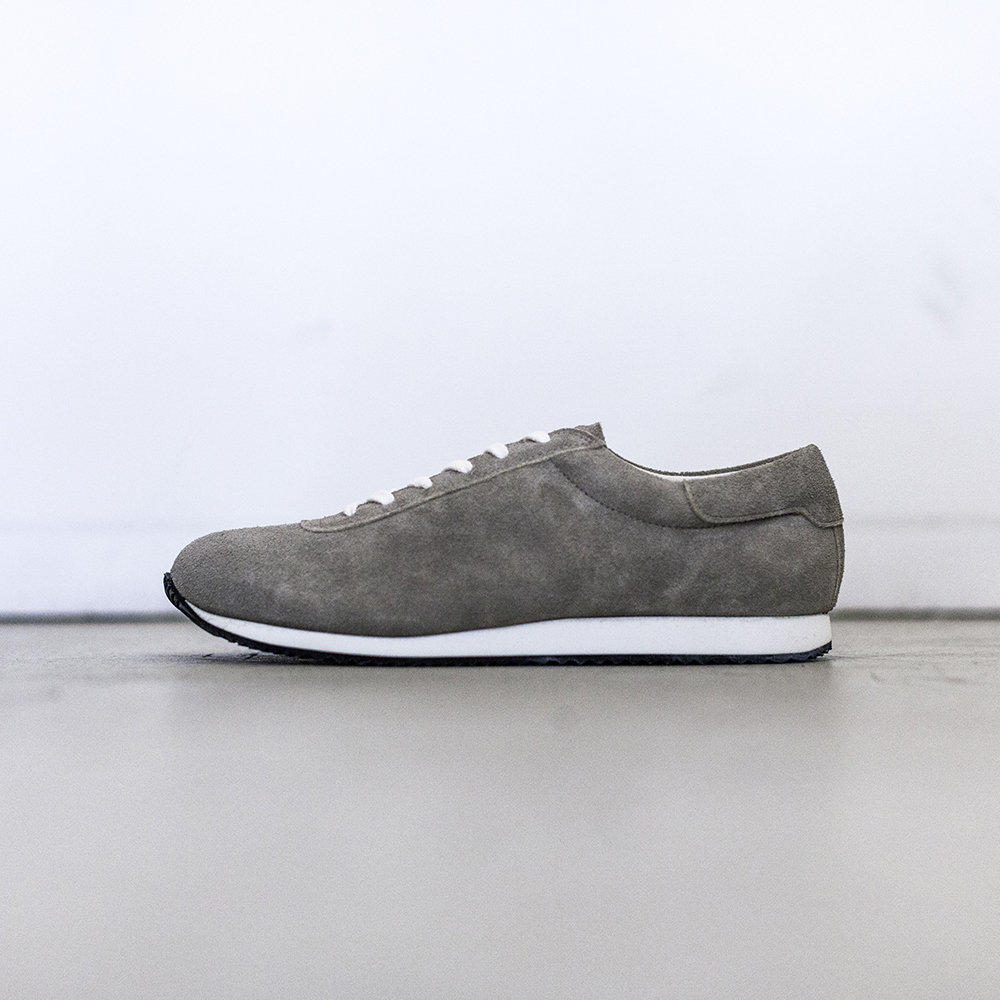
Egawa
Recently, you have been specifying the origin of each part on part of your product pages. Isn't this a move based on the concept stated above, that the wearer "becomes part of a healthy cycle"?
Watari
Yes. The phrase "Be part of a healthy cycle" is a little difficult to understand, but if you think about it more simply, it means supporting the region that has been diligently making the shoes. When you wear them with that in mind, you also feel good. I hope that people will take it that way.
Egawa
That's right. I want to cherish them. I want to support them. I want to inspire that feeling in everyone who wears them.
We believe that by continuing to care for and repair your Blue Over shoes, you will eventually be able to reinvent them into their true form. Over time, the natural beauty of the shoes will deepen, and they will become like a friend, both ordinary and special.
Egawa
This part is very Blue Over-esque, and at the same time, it's a bold expression.
Watari
A bold statement...? Which part?
Egawa
The true essence of Blueover is not when the shoes are new, but when they are being worn with care...
Watari
I've always thought so. The "true form" of Blue Over is when it becomes a shoe that has been worn for a long time and has acquired a certain character, and at the same time, it becomes a shoe that evokes the process of the wearer's own growth as a footprint. As proof that we were able to cherish the time we spent together.
Egawa
That's deep
Watari
In that sense, the story of Blueover doesn't end when the shoes are completed as a product; it continues even while you are wearing them.
Egawa
I see. That's what you want to convey to "everyone who wears them."
Watari
Actually, that's not all. I've always wanted to create something that would help the wearer to accept themselves. I guess you could call it "self-affirmation."
Egawa
Self-affirmation, huh?
Watari
Nowadays, we are overwhelmed with all kinds of information, and the act of trust itself takes energy. In such a world, we want to create something that can be trusted. Not just in terms of quality, but something that can be trusted as a brand. And we want to be a brand that makes the owner feel glad that they chose it.
Egawa
So, in this world of information overload, if you wear Blue Overcoats, you won't have to worry about what to buy when it comes to shoes! So, it's like a kind of talisman?
Certainly, if you choose things like that, you will have a solid foundation. It seems like you will be able to maintain a good mood.
Watari
We live in a diverse society where individuals can express their opinions. While this is a very good thing, it also means that the proliferation of information has made it difficult to find the information you want.
Egawa
That's the difficult part.
Watari
If that's the case, I thought I'd talk about it myself and tell you what I'm thinking as I move forward with Blue Over.
Egawa
This is the main theme of this series, but even if your voice becomes one of many, it's not a reason not to make your voice heard.
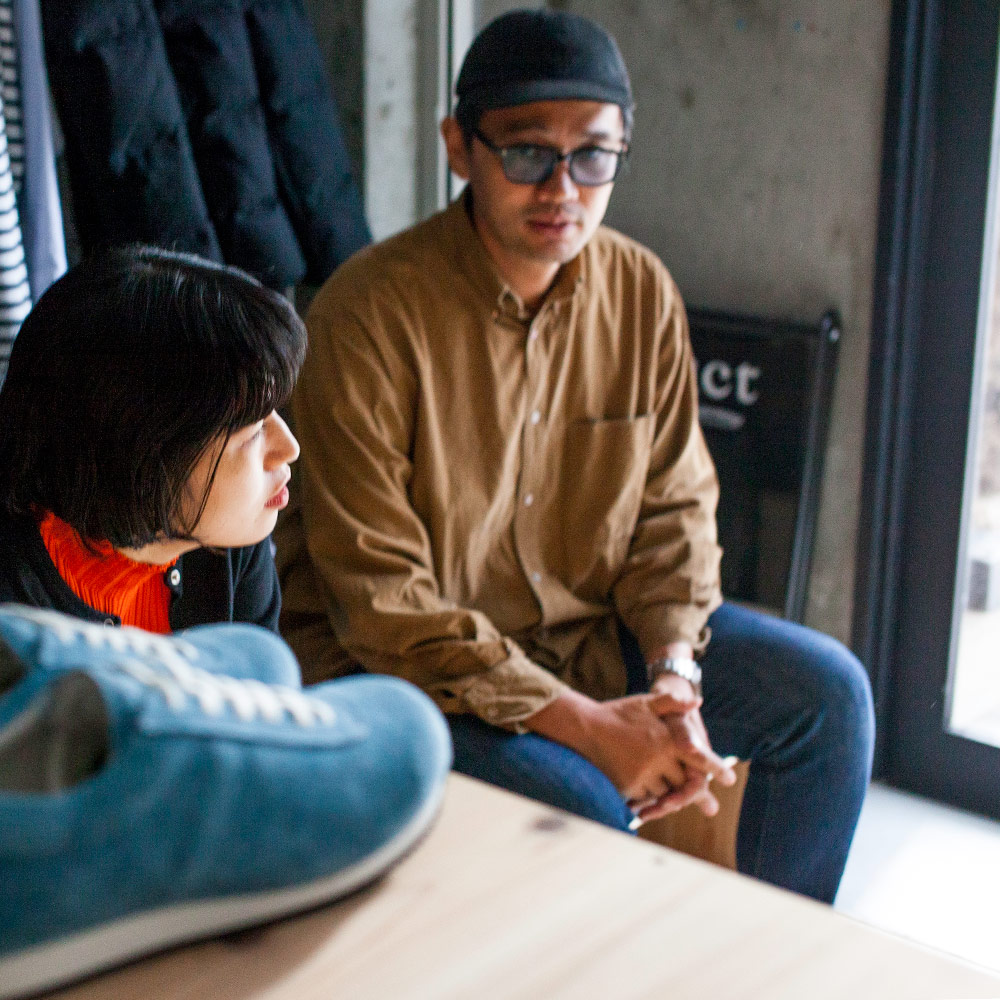
The meaning of wearing a blue coat
I hope that those who wear these shoes will be able to have a healthy mind and also have the opportunity to spend a peaceful and warm time.
Egawa
So, to sum up...Blueover shoes are not only comfortable to wear, but they also make you feel good, right? (laughs)
Watari
If that's the case, I'd be happy. I want people to know the background of Blue Over and then wear them. As a product, it's obviously a shoe that focuses on "walking," but by choosing it after knowing the brand's philosophy, people can live a little more comfortably and their antennae become more sensitive to living comfortably. It changes the scenery of their life a little. That's the feeling I get.
Egawa
The view of life? If you realize that there are people who make not only the shoes you wear, but also the clothes you wear and the furniture you use, and use that as a criterion for choosing things, the view may certainly look different. I hope that people can feel that way through Blue Over's content.
Watari
Well, I don't usually talk about it in detail, so it's a bit embarrassing to say it myself...
To the accumulated shoemaking techniques and those who inherit them, and to those who wear the shoes they create. Blueover wants to be a healthy and beautiful sneaker made in Japan. We hope that it will take shape over time for the wearer, becoming a memorable and beautiful shoe for you.
Watari
Blue Over may be a shoe you can find anywhere, but it's more than just shoes. That's the way we want people to think of them. We want to leave a legacy of people and culture through our shoes, and for people who wear them to feel the beauty of the Japanese identity that has been passed down through the generations. To achieve this, we believe that our shoes themselves must be healthy, beautiful, and made to last.
Egawa
That's right. In this age where there is an abundance of things and information, it's not easy to find sneakers like Blue Over and have people appreciate their quality...
Watari
Well, yeah
Egawa
But that's no reason not to spread the word. This time, I was able to hear directly from Watari about his feelings for Blue Over. I hope that this feeling will reach the customers who support us. I also hope that store manager Harada-san will continue to spread the word at the flagship store Struct!
Watari
That's right. It's really a brand that exists thanks to the support of our customers for the past 10 years.
Egawa
Blue Over's true form comes when it is worn with care... In other words, Blue Over exists because of the customers who wear it. Also, thank you to everyone who has read this far!
Watari
thank you
